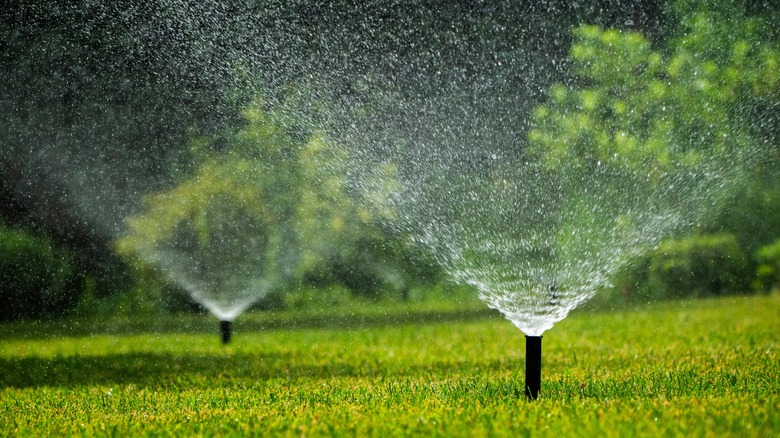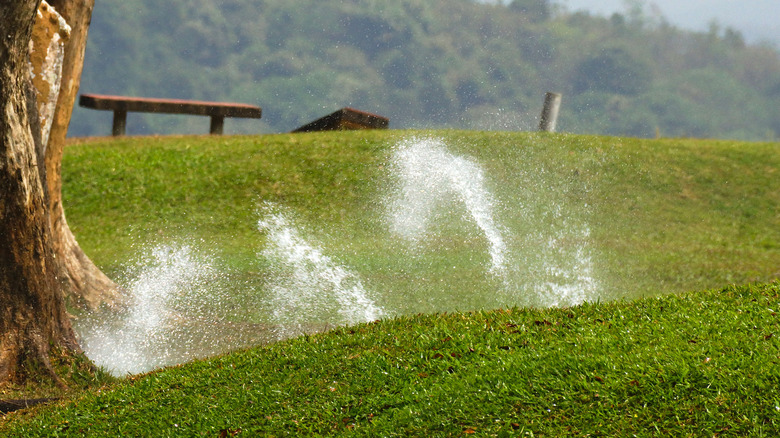How Long You Should Water Your Grass Lawn To Maintain A Lush, Green Oasis
You might already know about the best time to water your lawn. (It's morning.) However, just how much water should you give each time? Most lawns need between 1 and 1½ inches of moisture per week. Both rainfall and water from a sprinkler system count toward this amount. Although it's great to know that number, you might now be wondering how to achieve it. To maintain the strongest root system, you should water twice a week once you've established a lawn. Watering deeply and infrequently like this encourages the roots to grow deeper in the soil and improves drought resistance. A typical sprinkler applies 1 inch of moisture per hour. This means you should use the sprinkler for 30 to 45 minutes per week, twice a week.
Simple enough, right? Sure, as long as you can accurately measure the water going onto the grass, especially with rain mixed in. You might put a couple of rain gauges around the perimeter of the lawn to receive an accurate measurement of the rainfall, or use a spike rain gauge on the ground to measure the sprinkler's output. The gauge must be level to the ground. Measure and empty it after each use, before evaporation can remove water from it. If you want a cheaper alternative, place clean and empty tuna cans on the ground and measure the water with a ruler. Another option is a flow timer that measures the gallons of water passing through it. Use a multiplier of 0.62 gallons per square foot of yard to equal 1 inch of watering.
Some types of lawns need longer watering sessions
To further complicate things, certain types of grass and soil may need more or less water than the average. Cool-season grasses, which can include bluegrass, rye, and fescue, need 1 to 1½ inches of moisture per week, so you should water them twice a week for 30 to 45 minutes at a time, based on an average sprinkler delivering 1 inch of moisture per hour. But warm-season grasses, which include Bermuda, centipede, and zoysia, need less frequent watering for about 1 inch of moisture per week, meaning running the sprinklers twice a week for 30 minutes should be sufficient.
You may also have to take some different steps when watering your grass on a hill. For a sloped yard, you could lose some of the water to runoff. A technique called cycle and soak can help you use the sprinkler more efficiently to keep the grass lush and healthy. Adjust your schedule to split the time into two closely spaced waterings to give the water more time to soak into the soil instead of running off. For example, if you plan to run the sprinkler 40 minutes twice a week, use the sprinkler on the sloped area for 20 minutes, wait an hour or so, and then water another 20 minutes.
If you have sandy soil, consider watering more frequently and for less time. Sandy soil should only be wet to the root zone. If you have primarily clay soil, follow the cycle and soak method.
How to adjust your watering for rainfall
Another reason you might need to adjust how long you water your lawn is because of rainfall. One of the mistakes everyone makes when watering their lawn is overwatering right before or after rain falls. Such issues may explain sparse grass growth or the sudden appearance of weeds.
To maintain an accurate watering schedule, just do a little math after measuring the moisture that fell. You'll need at least one rain gauge, or use the empty tuna can trick. For example, if the gauge says you received 1/2 inch of rain in one storm, you can probably skip the upcoming sprinkler session if you planned to water for about 30 minutes. If you received 1/4 inch of rain, you can shorten your next sprinkler session to about 15 minutes.
Pay attention to the intensity of the rain as well. If it falls fast and hard, you'll have more runoff, so you may need to use the sprinkler a little more. A slow, steady rain should soak in almost entirely. Take note of upcoming weather forecasts, too. If you expect to have a storm tomorrow, try to avoid watering or water for less time today. If you have automatic sprinklers, you will need to override them when rain is in the forecast. Pay close attention to the forecast within a day of the storm, as it's usually accurate within a few tenths of an inch of the total expected rain. Weather forecasts one day out are accurate 96% to 98% of the time.


